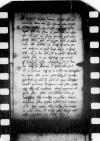List #379
Andrzej KRZYCKI (CRICIUS) do Ioannes DANTISCUSPiotrków, 1523-10-22
Rękopiśmienne podstawy źródłowe:
Pomocnicze podstawy źródłowe:
| ||||||
Tekst + aparat krytyczny + komentarz Zwykły tekst Tekst + komentarz Tekst + aparat krytyczny
Venerabili Domino
Mi carissime Domine Ioannes.
Ostendit mihi dominus
Feratis aequo animo pro vestra prudentia id, quod bonis praecipue et dignis viris, non in hac solum, sed in omnibus aliis aulis accidere solet, et non despondeatis mox animum ex huiusmodi aulicis adversitatibus, sed, cum locus hic ludus sit fortunae, si quid cadit, quod non ex sententia neque ex re videtur, arte est corrigendum.
De
Optime valete.
Vester


 BCz, 243, p. 72
BCz, 243, p. 72